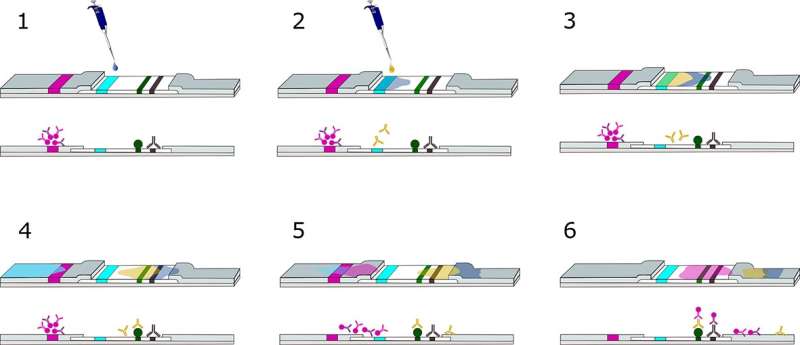"Stepwise description of the rSP03B sero-strip principle: To start the test a buffer is deposited on the sample line (NC membrane) (1). Immediately after applying the buffer, the sample is spotted on the same position (2). Both the buffer and the sample will migrate to the upper part of the strip. The anti-rSP03B Abs present in the sample get captured by the rSP03B Ag coated on the test line (3). The strip is then immediately dipped into the migration buffer solution (4). After which the colloidal gold conjugate mixture gets hydrated and starts migrating upwards together with the moving liquid (5). The anti-dog IgG Ab-gold conjugate binds to the dog IgG Abs on the test line. The colloidal gold control conjugate is captured by the GAC Abs present at the control line (6). NC, Nitrocellulose; Abs, Antibodies; Ag, Antigen; GAC, Goat anti-chicken." Credit: Willen, et al. (2018)
Dogs infected with Leishmania infantum, a parasite transmitted by the sand fly Phlebotomus perniciosus, are at risk for spreading leishmaniasis infections to humans. A new test, described and evaluated this week in PLOS Neglected Tropical Diseases, provides an easier-than-ever way to test dogs for exposure to P. perniciosus sand flies, and could be used in monitoring the effectiveness of sand fly control efforts.
Canine leishmaniasis (CanL) is a severe multi-systemic disease of dogs that has been reported throughout countries in Latin America, Europe, and Asia. Over 2.5 million dogs are estimated to be infected in southern Europe and the infection is difficult to treat. Control efforts often revolve around targeting sand fly populations. Current ELISA tests, for the presence of a P. perniciosus sand fly saliva protein, are limited to use in a laboratory— rather than field— setting.
In the new work, Laura Willen, of Charles University, Czech Republic, and colleagues prepared an immunochromatographic test (ICT) to rapidly screen dogs for the presence of P. perniciosus. The ICT detects the same antibodies against the fly's salivary protein—SP03B—as an existing ELISA test. To optimize the test, the team used 53 laboratory-bred Beagles that had either been exposed or unexposed to 200 P. perniciosus sand flies.
When they compared the ICT to two existing ELISA tests, results were in nearly 100% agreement and the ICT was found to have a sensitivity of 100% and a specificity of 86.79%. Raising the detection limit of the test would lead to a specificity of 96.23% without changing the sensitivity.
"This test is easily operated with no requirements for skilled personnel or specialized equipment," the researchers say. "In order to confirm the field detection accuracy and applicability of the test, further evaluation of canine populations exposed to various frequencies of sand fly bites and validation of the test with whole canine blood is required."
More information: Willen L, Mertens P, Volf P (2018) Evaluation of the rSP03B sero-strip, a newly proposed rapid test for canine exposure to Phlebotomus perniciosus, vector of Leishmania infantum. PLOS Neglected Tropical Diseases 12(8): e0006607. doi.org/10.1371/journal.pntd.0006607
Journal information: PLoS Neglected Tropical Diseases
Provided by Public Library of Science






















